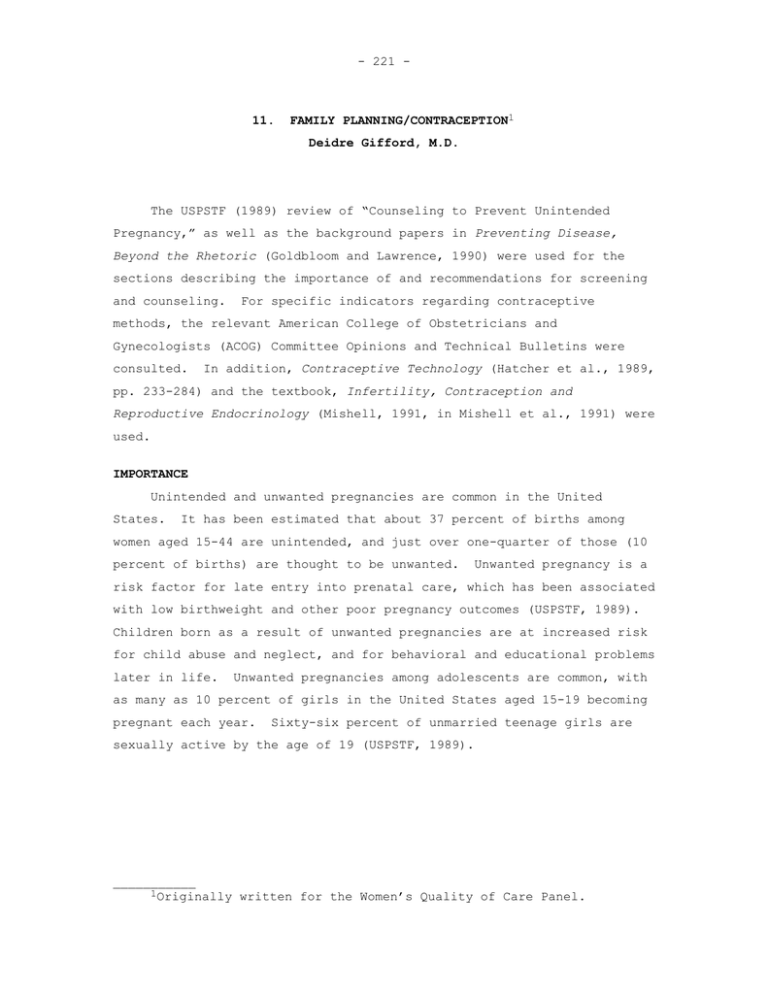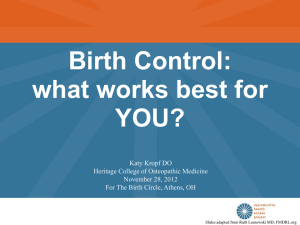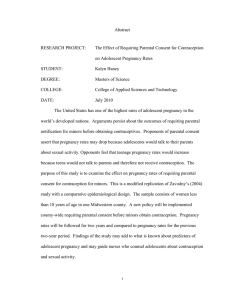- 221 - Preventing Disease,
advertisement

- 221 - 11. FAMILY PLANNING/CONTRACEPTION1 Deidre Gifford, M.D. The USPSTF (1989) review of “Counseling to Prevent Unintended Pregnancy,” as well as the background papers in Preventing Disease, Beyond the Rhetoric (Goldbloom and Lawrence, 1990) were used for the sections describing the importance of and recommendations for screening and counseling. For specific indicators regarding contraceptive methods, the relevant American College of Obstetricians and Gynecologists (ACOG) Committee Opinions and Technical Bulletins were consulted. In addition, Contraceptive Technology (Hatcher et al., 1989, pp. 233-284) and the textbook, Infertility, Contraception and Reproductive Endocrinology (Mishell, 1991, in Mishell et al., 1991) were used. IMPORTANCE Unintended and unwanted pregnancies are common in the United States. It has been estimated that about 37 percent of births among women aged 15-44 are unintended, and just over one-quarter of those (10 percent of births) are thought to be unwanted. Unwanted pregnancy is a risk factor for late entry into prenatal care, which has been associated with low birthweight and other poor pregnancy outcomes (USPSTF, 1989). Children born as a result of unwanted pregnancies are at increased risk for child abuse and neglect, and for behavioral and educational problems later in life. Unwanted pregnancies among adolescents are common, with as many as 10 percent of girls in the United States aged 15-19 becoming pregnant each year. Sixty-six percent of unmarried teenage girls are sexually active by the age of 19 (USPSTF, 1989). ___________ 1Originally written for the Women’s Quality of Care Panel. - 222 - EFFICACY OF INTERVENTION Screening for Risk of Unintended Pregnancy While there is no direct evidence available that taking a sexual history and offering contraception when appropriate will lower the rate of unintended pregnancy, counseling to prevent unintended pregnancy is widely recommended (USPSTF, 1989; Fielding and Williams, 1990, in Goldbloom and Lawrence, 1990). Except for abstinence, the most highly effective methods of contraception (hormonal methods, sterilization, and IUD) all require a visit to a health professional. There is evidence that teens who use hormonal methods of contraception are less likely to have an unwanted pregnancy than those using nonprescription contraceptives. Physicians, and others providing primary care to women, who do not ask about sexual activity and contraceptive practices may miss the opportunity to offer an intervention (contraception) which is known to be effective in preventing a serious adverse health outcome (unintended pregnancy). One study of Canadian teens revealed that although 85 percent had seen their doctor in the preceding year, only one third of sexually active girls had ever discussed contraception with their doctors (Feldman, 1990, in Goldbloom and Lawrence, 1990). According to a report by the World Health Organization, if all sexually active couples had routinely used effective contraception in 1980, there would have been almost 1 million fewer abortions, 340,000 fewer unintended births, 5,000 fewer infant deaths, and a reduction in the infant mortality rate of 10 percent (IOM, 1995). Furthermore, if the proportion of unintended pregnancies were reduced by 30 percent in the U.S., there would be 200,000 fewer unwanted births, and 800,000 fewer abortions each year (IOM, 1995). Once it has been determined that an individual is at risk for unintended pregnancy (i.e., is sexually active without contraception or with ineffective contraception and does not desire pregnancy at that time), it is appropriate to discuss the risks and benefits of the various methods, and to offer the most acceptable contraceptive method (USPSTF, 1989; Fielding and Williams, 1990, in Goldbloom and Lawrence, 1990). In a recent report on prevention of unintended pregnancy, the - 223 - IOM (1995) concluded that “...too few providers of health care...use all available opportunities to discuss contraception and the importance of intended pregnancy to the health and well-being of women and men, children and families.” The appropriate interval for screening for risk of unintended pregnancy has not been determined. Treatment Highly effective methods exist for preventing unintended pregnancy. These include abstinence, sterilization, hormonal contraceptives (oral, injectable, and implants), intra-uterine devices and barrier methods. Other methods, such as periodic abstinence, coitus interruptus and spermicides are less effective. Oral contraceptives (OCs) are the most commonly used non-permanent form of contraception in the United States. Approximately 10 million women in the U.S. currently use this method (USPSTF, 1989). OCs generally contain both an estrogen and progestin component (“combination” OCs), although a progestin only pill is also available. Combination OCs are highly effective in preventing pregnancy, with failure rates of 0.1 to 3.0 percent. In actual use, they may be less effective in teen-aged girls because of a lack of compliance (Hatcher et al., 1989; ACOG Technical Bulletin, 1994). In their original formulation, combination pills contained 50 mcg of synthetic estrogen, while the majority of OCs prescribed today contain 35 mcg or less. While OCs have many non-contraceptive benefits (e.g., reduction in menstrual flow, decreased dysmenorrhea, decreased anemia, lower risk of ovarian and endometrial cancer) (ACOG Technical Bulletin, 1994), they are also associated with health risks which may exceed their contraceptive benefit in some groups of women. Specifically, women who smoke and take oral contraceptives are at increased risk of cardiovascular disease when compared to non-smoking OC users. The Royal College of General Practitioners’ OC study (Croft and Hannaford, 1989) recruited 1400 OC users and 1400 non-users in 1968 and has followed this cohort to study the health effects of OC use. A nested case-control study using these data showed that neither current nor past OC use was a risk factor for myocardial infarction (MI) when other risk factors were - 224 - controlled for. However, OC users who smoked were at increased risk of MI compared to non-smoking OC users. Those who smoked fewer than 15 cigarettes per day had a relative risk of MI of 3.5 (95 percent CI 1.39.5), and those who smoked more than 15 cigarettes per day had a relative risk of MI of 20.8 (5.2-83.1). (These relative risks are not adjusted for age, hypertension or other risk factors for MI.) Although data on OC formulation were not reported, many of the pill users in this study were likely to have been using a 50 mcg OC at the time of recruitment. Data regarding the risk of smoking and low-dose OC use, stratified by age, are not available. RECOMMENDED QUALITY INDICATORS FOR FAMILY PLANNING/CONTRACEPTION The following criteria apply to all post-menarchal girls up to age 18 for whom the medical record documents a history of vaginal intercourse; selected indicators also apply to adolescent boys (ages 13-18). Screening Indicator 1. A history to determine risk for unintended pregnancy should be taken yearly on all women. In order to establish risk, the following elements of the history need to be documented: a. Menstrual status (e.g., pre- or postmenopausal, history of hysterectomy, etc.), last menstrual period, or pregnancy test; b. Sexual history (presence or absence of current sexual intercourse); c. Current contraceptive practices; d. Desire for pregnancy. Quality of evidence III Literature Benefits Comments USPSTF, 1989 Prevent unwanted pregnancies and births. Prevent abortions. The USPSTF does not make a recommendation for screening interval. As many as 37% of births among women aged 15-44 are unintended and over one quarter are unwanted. The goal of these recommendations is to identify women at risk for unintended pregnancies and counsel appropriately those who are interested in contraception. Quality of evidence III Literature Benefits Comments USPSTF, 1989 Prevent unwanted pregnancies and births. Prevent abortions. II ACOG Technical Bulletin, 1994 Prevent myocardial infarction and other thromboembolic complications.* Women at risk for unintended pregnancy are those who are sexually active without effective contraception and who do not desire pregnancy. Effective contraception is defined as: 1) Hormonal contraception (OC, injectable prostaglandins or implants) 2) IUD 3) Barrier + spermicide 4) Sterilization 5) Complete abstinence Women who smoke and use combination oral contraceptives (containing both estrogen and progestin component) are at risk for myocardial infarction (relative risk is 20 times greater than in women who do not smoke). Therefore, if prescribing oral contraceptives, the smoking status should be documented. Treatment Indicator 2. All adolescent girls and boys at risk for unintended pregnancy (i.e., sexually active) should receive counseling about effective contraceptive methods. 3. The smoking status of all women prescribed combination OCs should be documented in the medical record. 225 4. All women who smoke and are prescribed oral contraceptives should be counseled and encouraged to quit smoking. II-2 Croft and Hannaford, 1989; Kottke et al., 1988 Prevent myocardial infarction and other thromboembolic complications.* Because smoking increases risk of MI among women using oral contraception, and also has other long term toxicities (lung cancer, chronic lung disease, etc.), women should be counseled to quit. Counseling by physicians has been shown to be effective. *Thromboembolic complications include myocardial infarction, cerebrovascular accident, thrombophlebitis, and pulmonary emboli. Quality of Evidence Codes: I: II-1: II-2: II-3: III: RCT Nonrandomized controlled trials Cohort or case analysis Multiple time series Opinions or descriptive studies 226 - 227 - REFERENCES - FAMILY PLANNING/CONTRACEPTION American College of Obstetricians and Gynecologists. October 1994. Hormonal contraception. ACOG Technical Bulletin 198: 1-12. Croft P, and PC Hannaford. 21 January 1989. Risk factors for acute myocardial infarction in women: Evidence from the Royal College of General Practitioners' oral contraception study. British Medical Journal 298: 165-8. Feldman W. 1990. Unwanted teenage pregnancy: A Canadian perspective. In Preventing Disease: Beyond the Rhetoric. Editors Goldbloom RB, and RS Lawrence, 92-3. New York, NY: Springer-Verlag. Fielding JE, and CA Williams. 1990. Unwanted teenage pregnancy: A US perspective. In Preventing Disease: Beyond the Rhetoric. Editors Goldbloom RB, and RS Lawrence, 94-100. New York, NY: SpringeVerlag. Hatcher RA, J Trussell, F Stewart, et al. 1994. The pill: Combined oral contraceptives. In Contraceptive Technology, 16th revised ed. 22384. New York, NY: Irvington Publishers, Inc. Institute of Medicine, Committee on Unintended Pregnancy. 1995. The Best Intentions: Unintended Pregnancy and the Well-Being of Children and Families. Washington, DC: National Academy Press. Kottke TE, RN Battista, GH DeFriese, et al. 20 May 1988. Attributes of successful smoking cessation interventions in medical practice: A meta-analysis of 39 controlled trials. Journal of the American Medical Association 259 (19): 2883-9. Mishell DR. 1991. Oral steroid contraceptives. In Infertility, Contraception and Reproductive Endocrinology, Third ed. Editors Mishell DR, V Davajan, and RA Lobo, 839-71. Boston, MA: Blackwell Scientific Publications. U.S. Preventive Services Task Force. 1989. Guide to Clinical Preventive Services: An Assessment of the Effectiveness of 169 Interventions. Baltimore, MD: Williams and Wilkins.



